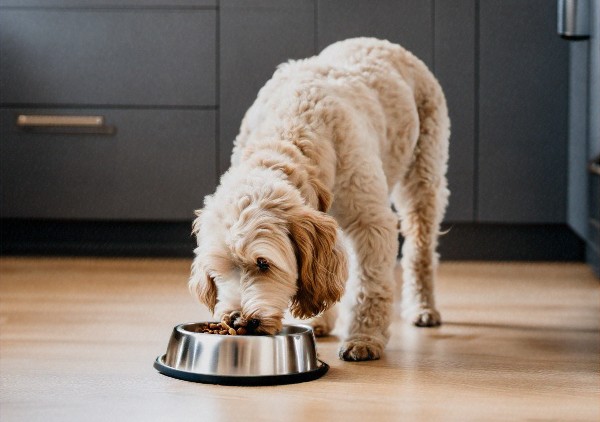How to use Dog Food Toppers

DogFoodAdvisor is reader supported See how
Dog Food Advisor is 100% impartial and is never paid to promote any brand. But if you buy using links on this page, we may earn a referral fee.
We might think of dog food toppers as a treat to entice our dogs to eat their meal, but they can be so much more. They can offer a way to enhance your pet’s meals with nutrition and exciting flavors. They can also help picky eaters by providing extra nutrients or a change in routine.
There are so many toppers on the market — not to mention fresh, wet, dried, baked, extruded and raw dog foods you can use as toppers — it can be challenging to understand how to use them effectively, so they enhance your dog’s diet rather than disrupt it.
For expert advice on using dog food toppers, we spoke to Dr. Renee Streeter, a Veterinary Nutritionist working with 5-star-rated dog food PetPlate, which offers a toppers plan.
Are dog food toppers good?
“Toppers can play a role in enhancing a dog’s diet, not just by making meals more palatable, but by providing additional nutrients that may be beneficial to their overall health,” says Dr. Streeter.
“Toppers can add beneficial nutrients like omega-3s for joint support or extra fiber for digestion, so the right topper can help address specific nutritional needs.”
Types of dog food toppers
Dog food toppers can be complete and balanced, meaning they provide essential nutrients in appropriate amounts and ratios, but that’s not always the case. Some examples of the various types of toppers are:
- Gravies, Bone Broths and Sauces: “Liquid toppers add moisture and flavor to dry kibble. They can be particularly useful for dogs that prefer a wet texture, have difficulty chewing dry food, or are in need of extra hydration,” says Dr. Streeter.
- Freeze-Dried and Dehydrated Toppers: “These toppers are convenient and have a long shelf life. When using freeze-dried or dehydrated toppers, make sure to follow instructions to rehydrate them properly. Using a brand that utilizes adequate kill-steps to ensure food safety is also crucial”
- Canned Foods: “Canned foods can be complete and balanced or foods for humans can also be toppers. Human foods that can be used as toppers and that are easily accessible at your local grocery store are things like pumpkin or tuna. They can add a variety of textures and flavor profiles to dry food.”
- Fresh Foods: “Cooked meats or vegetables are a great way to provide variety and additional nutrients. Always make sure that the fresh foods are dog-safe and prepared without harmful seasonings like garlic and onion. You can also buy pre-prepared fresh dog foods in smaller amounts to use alongside other types of dog food.”
- Dry food and Crunchy Treats: “Dry foods can be beneficial because they are often complete and balanced. These are often used as a crunchy addition to meals, especially when mixed with wet or fresh food.”
 Dog Food Toppers“>
Dog Food Toppers“>
Benefits of dog food toppers
- Enhanced Flavor and Palatability: One of the most common reasons pet parents use toppers is to make meals more appealing. “Whether your dog is a picky eater or just tired of their usual kibble, a topper can make mealtime more exciting,” says Dr. Streeter. “The added flavor and texture can encourage your dog to eat more so they get the nutrition they need.”
- Nutritional Boost: Toppers can be a good way to add extra nutrients to your dog’s diet. For example, you might add a topper rich in omega-3 fatty acids to support healthy skin and coat, or one with added fiber to aid digestion. “Some toppers are even formulated to help support pets with health concerns including issues like joint support, heart support or weight gain.”
- Hydration Support: “Toppers in gravy or broth form, can help with hydration. A hydrating topper can be particularly beneficial during hot weather or for dogs that don’t drink enough water on their own and even for dogs with kidney or bladder issues.”
How to use dog food toppers properly and effectively
- Consult Your Veterinarian: Before you make any significant changes in your dog’s diet, you should consult your vet. They can provide personalized advice and help you choose toppers that will benefit your dog’s health and well-being.
- Moderation is Key: Some toppers are complete and balanced meaning they provide all essential nutrients within appropriate quantities. These are often wet foods, dry foods, and fresh foods such as PetPlate. While toppers can be a great way to enhance your dog’s diet, any toppers which are not complete and balanced should be used in moderation.
“Excessive use of unbalanced toppers can lead to a nutrient imbalance or deficiencies in your dog’s diet,” says Dr. Streeter. “Unbalanced toppers which most often include gravies, sauces and broths, table foods, dehydrated toppers, and crunchy toppers, should be used as a supplement rather than a primary food source. The general rule of thumb is that all treats, table foods, and toppers that are not complete and balanced should make up no more than 10% of your dog’s daily calories.” - Balance and Variety: The great thing about toppers is that they are, usually, readily available and fairly inexpensive so you can try different toppers to see what your pup likes best. Plus, by incorporating different toppers into their diet you are allowing them to absorb a variety of nutrients.
- Check Ingredients and Nutritional Information: “Always read the labels of toppers to understand their ingredients and nutritional content. For toppers with added nutrients, ensure they complement your dog’s existing diet without causing toxicities or imbalances.”
- Monitor Your Dog’s Response: “Observe how your dog reacts to different toppers. If you notice any adverse reactions, such as digestive upset or changes in behavior, discontinue use and consult your vet. Each dog is unique, and what works for one may not work for another,”says Dr. Streeter.
Toppers can be a fantastic way to enhance your dog’s meals, offering additional flavor, variety, and nutritional benefits. By using toppers appropriately and considering your dog’s individual needs, you can make mealtime more enjoyable and support your dog’s overall health.
Remember to choose high-quality toppers, use them in moderation, and consult with your veterinarian to ensure the best results for your furry friend.
 Fresh Dog Food”>
Fresh Dog Food”>
Final word
The Dog Food Advisor does not accept money, gifts, samples or other incentives in exchange for special consideration in preparing our reviews.
However, we do receive a referral fee from online retailers (like Chewy or Amazon) and from sellers of perishable pet food when readers click over to their websites from ours. This helps cover the cost of operation of our free blog. Thanks for your support.
For more information, please visit our Disclaimer and Disclosure page.



